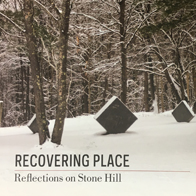
July 4–October 10, 2016
two-man saw
Two-man saw
Metal and wood
Late nineteenth–early twentieth century
Lent by Hopkins Memorial Forest–Farm Museum
TRANSCRIPT:
“First the forests, after that the huts, then the villages, next the cities, and finally the academies.” This, for the Renaissance philosopher Vico, “was the order of human institutions.” The evolution is not so linear here, where forest and academy coexist. Sometime after the glacier covering Stone Hill receded and the lake left in its wake had drained away, the trees returned, colonizing available territory. Much later, other forms of colonization would follow, with European settlers parceling out the land. In the eighteenth-century town books, a slanting hand records how they marked off the plots in rods, each corner described something like this: to a white oak staddle / to a dry pole marker / to a butternut bush / to a heap of stones by a beech tree. Of the Native American tribes that traversed this territory for generations, we know relatively little, though perhaps these woods would have been for them, as for those who came later, a source of food, and timber, and fuel. By 1830 most of the land had been cleared; in old barns, you can still see the tools with which they felled the trees and sawed the wood into boards, axes, adzes, and whipsaws like the one shown here, its crenellations shaped for hardwood or soft. The man holding the lower handle would stand in a pit they’d dug, the sawdust falling into his eyes. They knew Stone Hill through their labor; I know it as a place of rest.
At the intertwined trees in the meadow, where the birch and the hop hornbeams grow together, I tell my children the story of Baucis and Philemon, whom the gods allowed to grow together as trees after their death. As we hike in the woods, we look for the tall summit groves of hemlock, which are the last survivors of the pre-colonial forest, and for remains of the stone walls that the woods are once again overtaking. This place, I try to show them, is layered like the paper birch that are now giving way to the next generation of trees—to the oak, sugar maples, and beech. We peel the surface away, to see what lies underneath.

Jessica Fisher is author of two books of poetry: Frail-Craft, which won the 2006 Yale Younger Poets Prize, and Inmost (Nightboat Books, 2012). Her awards include the 2012–13 Rome Prize in Literature, given by the American Academy of Arts and Letters, and a fellowship from the Hellman Foundation. She is currently an assistant professor at Williams College.
Recovering Place: Reflecting on Stone Hill
By Mark C. Taylor
An illustrated book chronicling the land art and sculptures created by Mark C. Taylor at his home in the Berkshire hills, echoing themes found in the exhibition. Supported in part by Herbert A. Allen, Jr. and the Clark Art Institute and published by Columbia University Press. Call the Museum Store at 413 458 0520 to order.

